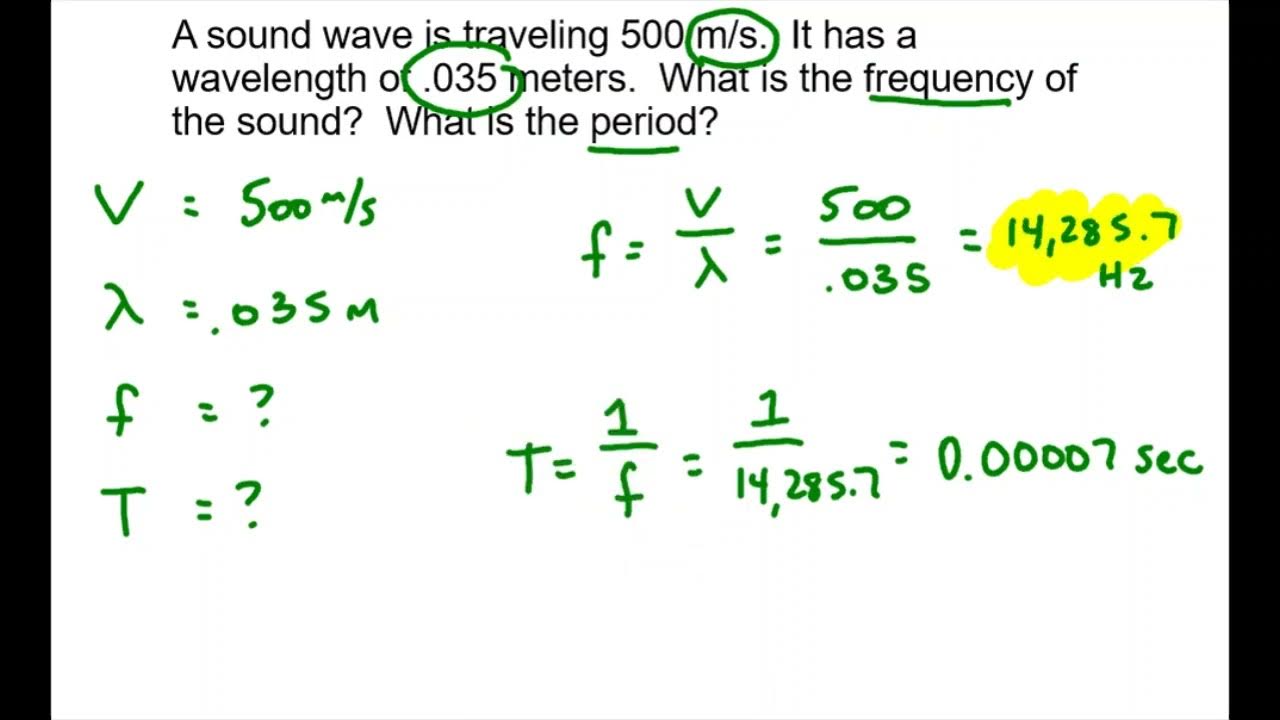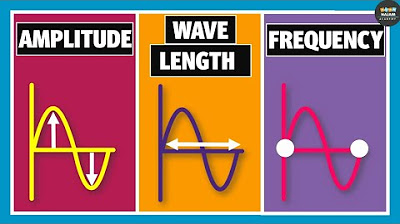High School Physics - The Wave Equation
TLDRThe video script by Mr. Fullerton introduces fundamental concepts of wave equations, focusing on the calculation and relationship between wave characteristics: frequency, period, wavelength, and wave velocity. It explains that frequency (measured in Hertz) is the number of waves passing a point per second, while the period is the time for a single wave to pass that point. The script clarifies that these two are reciprocals of each other. It further discusses how wave velocity, dependent on the type of wave and medium, relates to frequency and wavelength, as described by the wave equation. The video provides examples to illustrate these concepts, emphasizing that amplitude does not affect frequency. It concludes with a practical example involving a whale's water wave, demonstrating how to calculate wavelength from given velocity and period.
Takeaways
- 🌊 Frequency (F) is the number of waves passing a point in one second, measured in Hertz (Hz).
- 🔄 The period is the time taken for a single wave to pass a point, and is the reciprocal of frequency (1/F).
- 🌀 The relationship between frequency (F), period (T), and wave speed (v) is given by v = F × wavelength, and vice versa for wavelength.
- 📈 As wave speed is constant for a given medium, an increase in frequency results in a decrease in wavelength, and vice versa.
- 🌟 The speed of electromagnetic waves in a vacuum is a universal constant, denoted as 'c' and equal to 3 × 10^8 meters per second.
- 🌊 The amplitude of a wave is independent of its frequency; changing amplitude does not affect the frequency.
- 📌 To find the period of a wave, use the formula T = 1/F, and to find the wavelength, use λ = v/F.
- 🌊 For waves traveling through a vacuum, the wave speed is the speed of light (c), and the wavelength can be found using the formula λ = c/F.
- 🌊 In practical scenarios, such as water waves, both the velocity of the wave and the period can be used to calculate the wavelength.
- 📚 Understanding the interplay between frequency, period, wavelength, and wave speed is crucial for solving wave-related physics problems.
- 🌐 For more in-depth information on waves and their properties, consult resources like plusphysics.com.
Q & A
What is the definition of frequency in the context of waves?
-Frequency (F) describes the number of waves that pass a given point in a time period of one second. It is measured in Hertz (Hz), which is 1 over seconds.
How is the period of a wave related to its frequency?
-The period of a wave is the time it takes for a single wave to pass a given point, and it is the reciprocal of frequency. Mathematically, period (T) is equal to 1 over frequency (F), and frequency is equal to 1 over period.
What is the unit of measurement for period?
-The unit of measurement for period is seconds.
How do you calculate the period of a 60 Hertz electromagnetic wave traveling at 3 times 10 to the 8 meters per second?
-To calculate the period of a 60 Hertz wave, you take the reciprocal of the frequency. Since the frequency is 60 Hz, the period (T) is 1/60 seconds or approximately 0.0167 seconds.
What is the relationship between a wave's frequency, period, and the constant 'one'?
-The product of a wave's frequency and its period is always equal to one. This is derived from the relationship that period is the reciprocal of frequency, so when you multiply frequency (1/period) by period, the result is one.
How does wave velocity depend on the type of wave and the medium it travels through?
-Wave velocity is a function of both the type of wave and the medium it travels through. Different types of waves can travel at different speeds in the same medium, and the same type of wave can travel at different speeds in different media.
What is the speed of light, or the speed of electromagnetic waves in a vacuum?
-The speed of light, denoted as 'c', is 3 times 10 to the 8 meters per second. This is a fundamental constant in physics and represents the maximum speed at which all conventional matter and information in a vacuum can travel.
How does the wave equation relate frequency and wavelength?
-The wave equation states that the wave velocity is equal to the frequency (F) times the wavelength (λ). This relationship shows that for a given wave speed, as frequency increases, wavelength must decrease, and vice versa.
What happens to the frequency of a wave if its amplitude is increased?
-The amplitude of a wave is independent of its frequency. Therefore, increasing the amplitude of a wave does not affect its frequency; the frequency remains the same.
What is the period of an electromagnetic wave traveling through a vacuum with a wavelength of 1.5 times 10 to the minus 1 meters?
-Since the wave is an electromagnetic wave in a vacuum, its velocity is the speed of light (c). Using the wave equation (velocity = wavelength / period), we can find the period (T) by rearranging the formula to period = wavelength / velocity. So, T = (1.5 * 10^-1 meters) / (3 * 10^8 meters/second), which results in a period of 5 * 10^-10 seconds.
What is the wavelength of a water wave produced by a surfacing blue whale if it travels at 4.5 meters per second and has a period of 0.4 seconds?
-Using the wave equation and given the period (T = 0.4 seconds), we can find the wavelength (λ) by rearranging the formula to λ = velocity * period. Thus, λ = 4.5 meters/second * 0.4 seconds, which equals a wavelength of 1.8 meters.
Outlines
📚 Introduction to Wave Equation Concepts
This paragraph introduces the fundamentals of wave equations, focusing on the calculation of period, frequency, and wavelength, as well as their interrelationships. It explains that frequency (F) represents the number of waves passing a point per second, measured in Hertz (Hz). The period is defined as the time taken for a single wave to pass a point and is the reciprocal of frequency. The paragraph also discusses the concept of wave velocity, which depends on the type of wave and the medium it travels through, with a special emphasis on the speed of electromagnetic waves in a vacuum, denoted as C (3 x 10^8 meters per second). The wave equation is introduced, highlighting the relationship between wave velocity, frequency, and wavelength, where the velocity is the product of frequency and wavelength. The summary concludes with an example of how to calculate the period of a 60 Hz electromagnetic wave traveling at the speed of light.
🌐 Understanding the Wave Equation and Its Applications
This paragraph delves deeper into the wave equation and its practical applications. It clarifies the independence of amplitude and frequency, meaning that changes in amplitude do not affect the frequency of a wave. The discussion then moves on to calculating the period of an electromagnetic wave traveling through a vacuum with a given wavelength. By rearranging the wave equation and applying the relationship between period and frequency, the paragraph provides a step-by-step solution to find the period. Further, it addresses the calculation of wavelength when provided with the wave's amplitude and period, using the relationship between velocity, period, and wavelength. The example of a blue whale producing water waves with specific amplitude and period is used to illustrate the calculation of wavelength. The paragraph concludes by encouraging further exploration of wave equation concepts and providing a resource for additional information.
Mindmap
Keywords
💡Wave Equation
💡Frequency (F)
💡Period
💡Wavelength
💡Wave Velocity
💡Amplitude
💡Reciprocal
💡Speed of Light (C)
💡Physics
💡Electromagnetic Waves
💡Wave Properties
Highlights
The main objective is to understand the wave equation and calculate period, frequency, and wavelength.
Frequency (F) describes the number of waves passing a point in one second, measured in Hertz (Hz).
The period is the time taken for a single wave to pass a point and is the reciprocal of frequency.
The relationship between frequency and period is given by the formula: period = 1/frequency and frequency = 1/period.
The product of a wave's frequency and its period is always equal to 1.
Wave velocity depends on the type of wave and the medium it travels through.
Electromagnetic waves, like light, travel at 3 x 10^8 meters per second in a vacuum, a constant denoted as 'C'.
As frequency increases, wave velocity remains constant, and wavelength must decrease according to the wave equation.
The formula for wave velocity is velocity = frequency x wavelength.
Amplitude is independent of frequency; increasing amplitude does not affect the frequency of a wave.
For an electromagnetic wave in a vacuum, the wavelength and velocity are related by the equation: period = wavelength / velocity.
An example is given where a blue whale produces water waves with an amplitude of 1.2 meters every 0.4 seconds, and the wave travels at 4.5 meters per second.
The wavelength of a wave can be calculated using the formula: wavelength = velocity x period.
Understanding the wave equation and its components is essential for further study in physics.
The practical application of wave properties is demonstrated through the example of water waves created by a blue whale.
The relationship between frequency, period, wavelength, and wave velocity is fundamental to the study of wave phenomena.
The transcript provides a comprehensive introduction to the basic concepts and relationships in wave physics.
The wave equation and its implications are explained with clarity and practical examples.
The session concludes with an encouragement to seek further help and information for a deeper understanding of wave physics.
Transcripts
5.0 / 5 (0 votes)
Thanks for rating:





